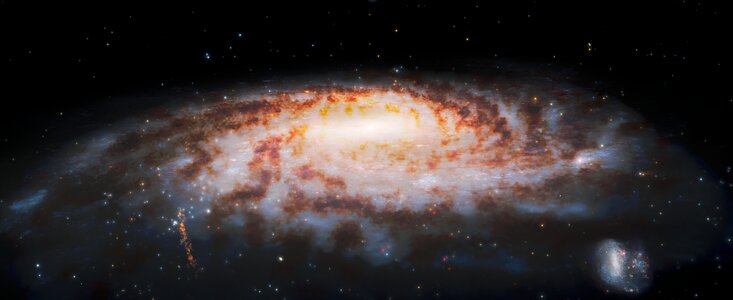

An amazing cosmic fossil just around the corner
5 January 2022
An international team of astronomers found a gigantic stream of stars at the south edge of our Milky Way. It is so large – its closest point to the center of our Milky Way is some 20,000 light years away and the farthest, 90,000 light years away from the heart of our galaxy – that if it were visible from our night sky, it would look 30 times larger than the full Moon!
The star stream, known as C-19, is a remnant of an ancient globular cluster. One intriguing thing about C-19 is that it has low “metallicity” – or elements heavier than helium – at least four times less than normal globular star clusters we know. In fact, C-19 has the lowest proportion of metals than has ever been observed for a stellar system in the Milky Way or its “neighbourhood”!
Astronomers used to believe star clusters with so few heavy elements would have disappeared long ago – some theories held that such clusters could not even be able to form at all. Observations with the Gemini North telescope in Hawaii suggest that C-19 must have formed long, long ago with the very first stars in the Universe.
C-19 can give us more clues about the formation of stars and star clusters that formed right after the Big Bang – and the great thing about it is that the cluster is relatively “close” to our home Earth, so we can study the structure of ancient galaxies in our cosmic neighbourhood.
Co-investigator Julio Navarro of the University of Victoria said: “while astronomers can look at the most distant galaxies to study the early Universe, we now know that it is possible to study the oldest structures in our own galaxy as fossils from those ancient times.”
In this animation, you’ll be able to see how C-19 possibly formed.
Image: The illustration shows the C-19 stellar stream in orange, at the lower left in the image.
Credit: International Gemini Observatory/NOIRLab/NSF/AURA/J. da Silva/Spaceengine Acknowledgment: M. Zamani (NSF’s NOIRLab)
Cool Fact
Although they have all the elements of our periodic table in them, stars are mainly composed of hydrogen and helium. Astronomer Cecilia Payne-Gaposchkin (1900-1979) was the first person to suggest that (in 1925!). Her idea was rejected at first, but further research proved she was right – Cecilia even became the first female professor at Harvard University.
